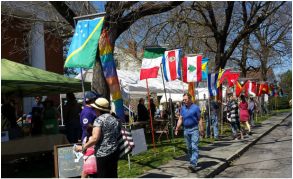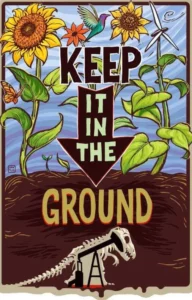Earth Day 2024: Bringing communities together
One billion people. That’s the number Earthday.org says they have been mobilizing annually to protect the planet. Their work goes on all year, but the Earth Day celebration itself is the largest civic event on Earth. In the midst of our global struggle with climate change, the Earth Day story is one of hope.
On April 22, 1970, 20 million Americans (10% of the population) across the country marched, advocating for greater environmental protections. It’s difficult to imagine that at the beginning of the 1970s most people simply accepted appalling levels of water and air pollution.
But in just over a year’s time, Gaylord Nelson, Democratic Senator from Wisconsin; his co-chair Pete McCloskey, Republican senator from California; and Denis Hayes, activist and organizer extraordinaire, managed to galvanize the nation: “a rare political alignment, enlisting support from Republicans and Democrats, rich and poor, urban dwellers and farmers, business and labor leaders.”
By the end of 1970, the United States Environmental Protection Agency was created, along with a number of environmental laws, including the National Environmental Education Act, the Occupational Safety and Health Act, and the Clean Air Act. Two years later congress passed the Clean Water Act. Every year since 1970, during the week of April 22, people around the world mark the anniversary of the birth of the environmental movement and the power of communities coming together.
My community
Last year on April 22 I strolled down historic Huguenot Street, heading toward the annual Earth Day fair at the Reformed Church of New Paltz, the town where my wife and I live. New Paltz, N.Y., population 14,000+, is 90 miles north of New York City, nestled in the mid-Hudson valley at the foot of the Shawangunk Mountain range.

As happens every Earth Day, more than 150 flags representing countries in the United Nations had been put up on both sides of the street, creating a pathway of brilliant bursts of color fluttering in the breeze, a reminder of our town’s place in a much larger global community.
The Earth Day fair is its own kind of hybrid. Fun and education mix seamlessly. There’s music from local groups playing everything from 70s rock to country, delicious food served with compostable tableware and utensils, and crafts for the children. Tents and booths shared by local businesses and nonprofit organizations beckon with interesting displays.
It’s so easy to mosey over and have a conversation with a representative from New York State’s Energy Research and Development Authority about community solar and community choice aggregation. Imagine getting your questions answered about these complicated options without suffering through an endless phone queue! Last year a local solar energy company brought their van, solar panels mounted on top, so people could play video games powered by solar energy.
Farms and agricultural organizations displayed their organically grown crops and information about food waste reduction initiatives. Enthusiastic staff were ready to explain that not using so many pesticides was helping protect our local watershed and that reducing waste was saving energy and reducing air, soil, and water pollution in the county.
I was excited to see the town’s new electric bus parked on the street so people could hop inside and take a look. The theme for 2024’s Earth Day is Planet vs. Plastics and I’m looking forward to volunteering at one of the booths again this year.
This vibrant community event has been bringing the town together since 2003. I asked my friend Jim O’Dowd, retired clinical social worker and long-time New Paltz resident and environmental activist, to tell me the story of how the fair started and some of the ways the community has been taking action locally.
The seed is planted
By 2000, Jim told me, he was steeped in the scientific reports that human behavior was involved with global warming. One day after seeing a magazine headline—“Can religion save the environment?”—he was moved to expand the question: “What if we combine the scientific with the ethical and the spiritual?”
The first step in this quest was the Caring for Creation committee he organized in his church, the Reformed Church of New Paltz. The group also reached out to other churches to consider what they could do together to promote environmental action and education. The result was New Paltz’s first Earth Day.

Adriana Havnaer, another core member of the Earth Day organizing committee, moved to New Paltz in 2001 and met Jim through the Caring for Creation committee. She’s also involved with the New Paltz Climate Action Coalition, a 501(c)3 run by a group of residents, who since 2007 have been addressing the causes and consequences of the climate crisis.
Like Jim, Adriana was struck by the possibilities that could happen through collaboration, as she put it, between the secular and the religious, businesses and nonprofits. Adriana told me she’s typically in charge of food for Earth Day, always a way to bring people together and educate at the same time. She explained how they kept their educational component small for their first couple events, championing Fair Trade coffee and chocolate, for example.
As the initial organizing group started reaching out to more faith communities and local
businesses, the event has grown significantly. The nonpartisan spirit is highlighted by the sponsors—Interfaith Earth Action, The Caring for Creation Committee of the Reformed Church of New Paltz, and the New Paltz Climate Action Coalition. And the business community has become a visible and valuable partner in showcasing the power of consumer choice in the low-carbon energy transition.
Moving beyond Earth Day
What’s so inspiring about Jim and Adriana and the many others contributing their time and energy to local climate activism is their continued commitment over many years despite the challenges: the pandemic, political divisions, budget constraints and, always, the tendency of us humans to resist change. As Jim explained, “We are a large group of people, and how often will everyone agree on everything?’’
But patience and negotiating skills pay off. For example, as part of their designation as a “Green Church,” the Reformed Church of New Paltz changed its cleaning and waste management procedures to be more environmentally friendly. They installed solar panels on their education building, which now provides energy for all four of the church’s buildings.
And they added heat pumps to the main church building, which is more than 100 years old, making it much more energy efficient. Jim pointed out that although there is an electric cost, there is no fossil fuel involved in that building. Using IRA benefits, they are now working on upgrading the other buildings. Jim and Adriana have also met with other faith communities in town, who have been making their own upgrades.
The town itself, spearheaded by the Climate Smart Task Force, has been certified by New York State as a bronze level “climate smart” community. The rigorous certification process came after completing “a suite of concrete actions that mitigate and adapt to climate change.”
These are only a few examples of progress made in the community, and I asked Jim and Adriana what they’ve learned after years of advocacy.
Lessons learned
Start with a core of dedicated members: Keeping a group active over the long run takes perseverance and a willingness to develop positive working relationships in the community. Everyone is busy, life gets complicated, and you need people you can depend on. And a good sense of humor helps!
Meet people where they are: Or as Jim wisely suggests, “Don’t beat people over the head.” I remember when I was still a financial adviser and transitioning my practice to sustainable investing, I found that most of my clients were very interested in the idea, but needed different strategies based on their individual lifestyles, values and financial goals. For a climate action group trying to persuade the board of a local organization that geothermal is the best option for their renovation, knowing the latest financing options for renewables and the long-term carbon reduction benefits can make the difference.
Start small: Years of working with groups to adopt change have taught Adriana that taking small steps rather than focusing on “grandiose” goals is a more successful strategy. One of her group’s first initiatives was eliminating the use of Styrofoam cups in the church. Small steps over time produced legislation at the county level in reducing plastic waste: After a campaign by numerous organizations, the Skip the Straw Law went into effect in 2019, requiring that any establishment providing prepared food for a customer provide single-use plastic straws, stirrers, cutlery and condiment packets to customers only on demand. One meal at a time does make a difference.
You don’t have to reinvent the wheel: A sage piece of advice that all of us in the sustainability arena can benefit from. Jim and Adriana have had success reaching out to people from other parts of the state and different parts of the country: What are they doing that could work locally? Are there ways to work together on certain issues? What can we learn? And Adriana points out how many resources are available to anyone looking for ideas.
For individuals, Adriana likes the Climate Action Now app, with fast and easy actions you can do right on your phone, every day. It’s set up as a B Corp, which means you can be part of lobbying for specific legislation. And the Earth Day Toolkit can save groups hours of strategizing.
What now?
I knew my colleague Peter Fusaro, founder of the Wall Street Green Summit, had been at the first Earth Day and that he has dedicated his career to working on environmental issues. I asked him how he thought things were going in 2024. “There I was in Pittsburgh Point Park,” he told me, “with my solar power tee shirt, celebrating Earth Day 1970 with thousands of people. I never thought that the green transformation would take so long as we are now in its 54th year.”
When I asked Jim for his opinion, he agreed that the picture right now is not very bright. “The climate change curve is trending upward toward dangerous consequences,” he said. “But given the many positive changes happening around the world, we’re hopeful the curve will begin bending downward. We know it’s going to take a lot of action from a lot of people, and that’s why in our little community, we’ve reached out to everybody—the Earth Day Fair invites the whole Community to gather here, in one spot.”
This is what I appreciate most about Earth Day: While enjoying the festivities, the town gets to see the sustainable initiatives that are creating opportunities for the local economy and making positive environmental impacts that directly affect everyone’s lives. We have the technology and scientific know-how to make the changes we need.
Every small step makes a difference, and on this day we celebrate the power of communities that are doing just that.



